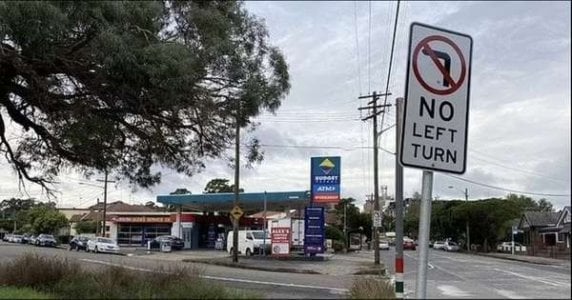Traffic Chaos Exposed: How One Controversial Sign Ignited a Battle Between Suburbs and What You Need to Know!
By
Seia Ibanez
- Replies 10
In the bustling streets of Sydney's inner west, a single road sign has become the unlikely catalyst for a heated dispute that has pitted neighbor against neighbor and left motorists in a state of exasperation. The 'no left turn' sign at Riverside Crescent, near Dulwich Hill, has sparked outrage and kilometers of traffic, leading to accusations that the local council is attempting to barricade the suburb from so-called 'invaders' from neighboring areas.
The sign, which was installed without prior community consultation in February 2021, has been a thorn in the side of local motorists. It blocks a crucial exit on the Dulwich Hill side of the Wardell Road bridge, a vital artery that spans the Cooks River and serves as a main thoroughfare for residents of the Inner West and the Canterbury-Bankstown LGAs.

The restriction has caused significant traffic delays, with queues stretching for kilometers as drivers are prevented from entering the intersection and accessing nearby suburbs. The frustration is palpable among the community, with one Earlwood resident humorously suggesting to news.com.au that the council might be trying to stop 'Canterbury invaders' from crossing the river into their domain.
The controversial sign is part of a broader initiative to construct a 6km bike path from the Cooks River to the northern part of the Parramatta River at Iron Cove. This project, funded through the state government's Get NSW Active program to the tune of $10 million, aims to promote cycling and walking. However, the execution has left much to be desired in the eyes of local drivers.
An engineering report by the Inner West council from 2018 downplayed the potential for traffic disruptions, but the reality has proven otherwise. A petition demanding the removal of the sign garnered almost 600 signatures, with 84 percent of motorists expressing dissatisfaction. Many residents were unaware of the sign's purpose, with some dismissing it as 'ridiculous or a joke.'
In response to the uproar, the council proposed a revised plan to allow vehicles over 6m in height to access the intersection and considered installing additional 'no left turn' signs further down Riverside Crescent. However, they did not offer the option to remove the sign entirely, much to the chagrin of the community.
Despite the petition and ongoing complaints, the council voted in December 2022 to keep the original sign in place. A council spokesman stated that the sign's purpose was to reduce traffic on local streets while facilitating cycling along the Greenway. Meanwhile, the City of Canterbury Bankstown has acknowledged the residents' concerns and communicated them to the Inner West Council, which is reviewing traffic conditions on Wardell Road.
The situation raises important questions about the balance between promoting active transport and managing traffic flow. It also highlights the need for community engagement and consultation when implementing changes that significantly impact daily life.

As members of the Seniors Discount Club, many of you have likely experienced similar frustrations with traffic management decisions in your own suburbs. We invite you to share your thoughts and experiences in the comments below. How do you think councils should handle the integration of active transport options with the needs of motorists? Have you encountered any road signs or changes that have made your daily commute more challenging? Let's discuss the best ways to achieve a harmonious coexistence on our roads.
The sign, which was installed without prior community consultation in February 2021, has been a thorn in the side of local motorists. It blocks a crucial exit on the Dulwich Hill side of the Wardell Road bridge, a vital artery that spans the Cooks River and serves as a main thoroughfare for residents of the Inner West and the Canterbury-Bankstown LGAs.

Motorists were outraged over the sign as it stopped drivers from entering the intersection and accessing several suburbs. Credit: Change.org
The restriction has caused significant traffic delays, with queues stretching for kilometers as drivers are prevented from entering the intersection and accessing nearby suburbs. The frustration is palpable among the community, with one Earlwood resident humorously suggesting to news.com.au that the council might be trying to stop 'Canterbury invaders' from crossing the river into their domain.
The controversial sign is part of a broader initiative to construct a 6km bike path from the Cooks River to the northern part of the Parramatta River at Iron Cove. This project, funded through the state government's Get NSW Active program to the tune of $10 million, aims to promote cycling and walking. However, the execution has left much to be desired in the eyes of local drivers.
An engineering report by the Inner West council from 2018 downplayed the potential for traffic disruptions, but the reality has proven otherwise. A petition demanding the removal of the sign garnered almost 600 signatures, with 84 percent of motorists expressing dissatisfaction. Many residents were unaware of the sign's purpose, with some dismissing it as 'ridiculous or a joke.'
In response to the uproar, the council proposed a revised plan to allow vehicles over 6m in height to access the intersection and considered installing additional 'no left turn' signs further down Riverside Crescent. However, they did not offer the option to remove the sign entirely, much to the chagrin of the community.
Despite the petition and ongoing complaints, the council voted in December 2022 to keep the original sign in place. A council spokesman stated that the sign's purpose was to reduce traffic on local streets while facilitating cycling along the Greenway. Meanwhile, the City of Canterbury Bankstown has acknowledged the residents' concerns and communicated them to the Inner West Council, which is reviewing traffic conditions on Wardell Road.
The situation raises important questions about the balance between promoting active transport and managing traffic flow. It also highlights the need for community engagement and consultation when implementing changes that significantly impact daily life.
Key Takeaways
- There is public outrage over a 'no left turn' road sign at Riverside Crescent in Sydney's inner west that is causing significant traffic congestion.
- The sign was installed as part of a major bike path project funded by the state government's Get NSW Active program and is intended to reduce local street traffic and support cycling.
- Residents have signed a petition demanding the removal of the sign after it led to long traffic delays, with many believing its installation is a joke or unnecessary.
- Despite protests and nearly 600 petition signatures, the Inner West Council voted to keep the sign, with revisions to allow vehicles over 6m in height to access the intersection, and considers the matter resolved.
As members of the Seniors Discount Club, many of you have likely experienced similar frustrations with traffic management decisions in your own suburbs. We invite you to share your thoughts and experiences in the comments below. How do you think councils should handle the integration of active transport options with the needs of motorists? Have you encountered any road signs or changes that have made your daily commute more challenging? Let's discuss the best ways to achieve a harmonious coexistence on our roads.







